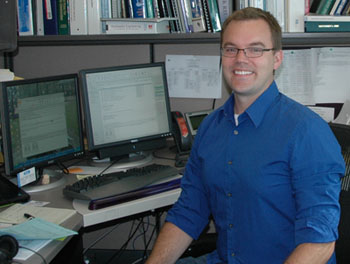By Libby Schultz

Neile Reider, MnDOT’s water services principle engineer, manages the wastewater treatment facilities that serve rest areas and truck stops. Photo by Libby Schultz |
Did you know MnDOT operates 57 wastewater treatment facilities and 77 drinking water systems throughout the state?
Neile Reider, MnDOT’s water services principle engineer, works with the districts to manage these facilities with the goal of protecting public health and the environment.
“What we do is important, because when we do our job right, people don’t get sick,” Reider said.
Newsline recently caught up with Reider to learn more about his work managing the wastewater treatment facilities that serve rest areas, truck stops and other state buildings visited daily by motorists.
What is a common misconception about wastewater treatment?
Right or wrong, the saying is: “the solution to pollution is dilution.” However, with low flow technology, we use less water, which is good; but we end up concentrating the waste stream, which is not so good. A higher strength waste stream means that we need more technology or processes to treat wastewater.
What is a unique aspect of your job?
The regulatory environment surrounding wastewater systems is unique. There are federal requirements, state requirements and local requirements. Within Minnesota, there are about 207 ordinances at the local level that deal with decentralized wastewater treatment systems. There are also specific licenses you need to hold to design, operate, maintain and inspect these systems.
Another unique aspect is that we get to work very closely and develop strong relationships with the districts throughout the entire planning, design and construction process to implement successful systems.
What do you find rewarding?
’Wastewater Treatment is simple. The really hard part is keeping it simple.’
This quote embodies what our unit does. The districts are taking care of these systems and we try to make these systems as easy as possible to operate and maintain while still effectively treating wastewater. If we do our job right, everyone else’s job is easier. That’s my reward.
Where do people see your work in action?
Every time you flush a toilet or take a drink of water at a rest area or truck stop. Truthfully, I would say that most people don’t see my work. The joke in the industry is that everyone flushes and forgets.
What would you like people to know about your job?
That what we do is important, because when we do our job right, people don’t get sick.
I think that people hear about public health and environmental protection and don’t realize what it really means. A chemist said in the July 1869 publication of Scientific American (July 24, 1869:57), “The present water closet system … merely removes the bulk of our excreta from our houses to choke our rivers with foul deposits and rot at our neighbors’ doors. It introduces into our houses a most deadly enemy.”
The idea of how to manage water and wastewater in the United States has been around for a long time. To reflect how we operate today, what I would say in 2012 is that the present water closet system … removes excreta from our houses and treats it to safe levels so we don’t impact our neighbors.
Do you or a co-worker have an interesting job to share with readers? Click here to send us your ideas, and we’ll contact you for more information.
Recent employee profiles:
|



